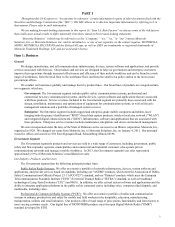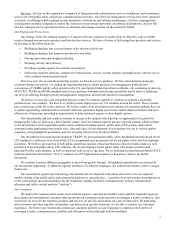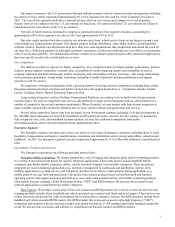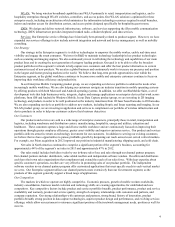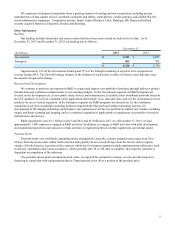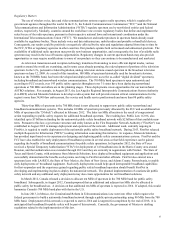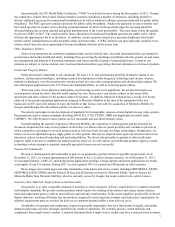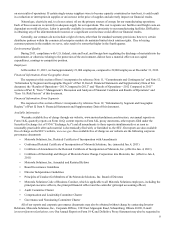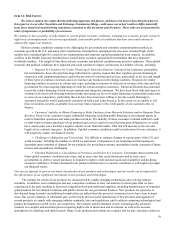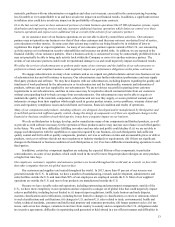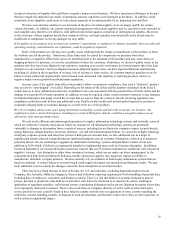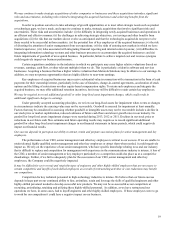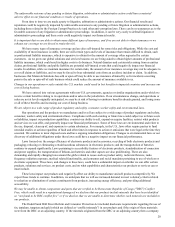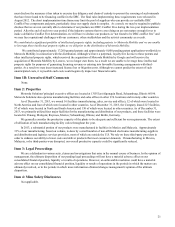Motorola 2013 Annual Report Download - page 13
Download and view the complete annual report
Please find page 13 of the 2013 Motorola annual report below. You can navigate through the pages in the report by either clicking on the pages listed below, or by using the keyword search tool below to find specific information within the annual report.11
completing development and introducing new products or technologies in the future. We may focus our resources on
technologies that do not become widely accepted or are not commercially viable or involve compliance obligations with
additional areas of regulatory requirements.
Our results are subject to risks related to our significant investment in developing and introducing new products. These
risks include among others: (i) difficulties and delays in the development, production, testing and marketing of products,
particularly when such activities are done through the use of third-party joint developers; (ii) customer acceptance of products;
(iii) the development of, approval of, and compliance with industry standards and regulatory requirements; (iv) the significant
amount of resources we must devote to the development of new technologies; and (v) the ability to differentiate our products
and compete with other companies in the same markets.
We are exposed to risks under large, multi-year system and solutions and services contracts that may negatively impact our
business.
We enter into large, multi-year system and solutions and services contracts with large municipal, state, nation-wide
government and enterprise customers. This exposes us to risks, including among others: (i) the technological risks, especially
when the contracts involve new technology; (ii) financial risks, including the estimates inherent in projecting costs associated
with large, long term contracts and the related impact on operating results; (iii) cyber security risk, especially in managed
services contracts with enterprise and public safety customers that process personal data; and (iv) political risk, especially
related to the contracts with government customers. In addition, multi-year awards from governmental customers may often
only receive partial funding initially and may typically be cancelable on short notice with limited penalties. Recovery of front
loaded capital expenditures in long-term managed services contracts with government and enterprise customers is dependent on
the continued viability of such customers. The termination of funding for a government program or insolvency of managed
services enterprise customers could result in a loss of anticipated future revenue attributable to that program, which could have
an adverse impact on our profitability.
The expansion of our global solutions and services business creates new competitors and new and increased areas of risk that
we have not been exposed to in the past and that we may not be able to properly assess or mitigate.
We plan to continue to expand our global solutions and services business by offering additional and expanded managed
services for existing and new types of customers, such as designing, building, operating, managing and in some cases owning a
public-safety system or other enterprise system. The offering of managed services involves the integration of multiple services,
multiple vendors and multiple technologies, requiring that we partner with other solutions and services providers, often on
multi-year projects. In some cases we must compete with a company in some business areas and cooperate with the same
company in other business areas. From time to time such projects may require that we form a joint venture with our partners.
Risks associated with expanding our managed services offerings include:
• We may be unable to recognize revenue from the sale of equipment in connection with managed services
contracts for a period of time, which may be several years.
• We may be required to agree to specific performance metrics that meet the customer's requirement for
network security, availability, reliability, maintenance and support and, in some cases, if these performance metrics are
not met we may not be paid.
• The managed services business is one characterized by large subcontracting arrangements and we may not be
able to obtain favorable contract terms or adequate indemnities or other protections from our subcontractors to
adequately mitigate our risk to our customers.
• We are facing increasing competition from traditional system integrators and the defense industry as solutions
and services contracts become larger and more complicated.
• Expansion will bring us into contact with new regulatory requirements and restrictions with which we will
have to comply and may increase the costs and delay or limit the range of new solutions and services which we will be
able to offer.
A portion of our business is dependent upon U.S. government contracts and grants, which are highly regulated and subject to
oversight audits by U.S. government representatives and subject to cancellations. Such audits could result in adverse findings
and negatively impact our business.
Our government business is subject to specific procurement regulations with numerous compliance requirements. These
requirements, although customary in U.S. government contracting, increase our performance and compliance costs. These costs
may increase in the future, thereby reducing our margins, which could have an adverse effect on our financial condition. Failure
to comply with these regulations could lead to suspension or debarment from U.S. government contracting or subcontracting
for a period of time, and the inability to receive future grants. Among the causes for debarment are violations of various laws,
including those related to procurement integrity, export control, U.S. government security regulations, employment practices,
protection of the environment, accuracy of records, proper recording of costs, foreign corruption and the False Claims Act.


